OK, I’ve been meaning to post this for a while. Here at last are some pictures of my Dulcitone. And I’ll tell you most of what I’ve managed to glean largely from searching the internet pretty intensely. There is very little information on dulcitones and very few people know about them.
Apparently there were about 6000 made between about 1850-ish and 1910-ish. Mine is number 1312. You can see this clearly in a couple of the photos. There are an estimated 2000 surviving examples. So, it’s a fairly rare instrument. They were made in Glasgow, Scotland. That happens to be my hometown, so the lure of the dulctione was hard for me to resist with that in the mix. The really early ones just have “Thomas Machell” on them rather than “Thomas Machell & Sons”. I am led to believe the instrument narrowly missed the broader success of it’s cousin the celeste. Tchaikovski wrote his “dance of the sugar plum fairy” with a dulcitone in mind, but when it came to playing it with the orchestra the dulcitone was too quiet, so he went for the celeste instead. I can’t verify this but it’s a nice story anyway.
The instrument became quite popular with British missionaries for services out in the jungles, praries or wherever else they were spreading Christianity. It was relatively portable and didn’t go out of tune.
The instrument is a wooden box with tuning forks and so called “English action” keyboard in it. That is adapted from a grand piano that strikes the piano strings from above the strings rather than the usual below. When a dulcitone key is pressed it lifts a damper from the tuning fork allowing the note to sustain when it is struck. Depressing the key returns the damper to the tuning fork apart from when the sustain pedal is pressed. The sustain pedal lifts all the dampers from the tuning forks.
It is an ancestor of the electric Rhodes and Wurlitzer pianos still in use today. If you’ve ever played either instrument unplugged you would find the dulcitone very familiar. It turns up on a few recordings. I understand some of the Harry Potter film theme is recorded with a dulcitone. Marillion have used it in places, as has Fiona Apple, and some more modern folk records. And of course, now me. It’s well suited for a certain ambience as it has quite a mysterious, gentle but slightly screwed up sound to it. The closest thing to it soundwise is quite possibly a marimba but if you think somewhere between a glockenspiel and a piano you’re in the right area. The tuning on mine is well flat of today’s standard tuning. I’m not sure if this is because of a trend for today’s instruments to be tuned sharper, but if you want to play guitar with it you need to tune down a fair bit.
I found mine on eBay. It was a californian seller. He had acquired it in turn from an “English country hotel”. It was quite expensive in reality, more so with the shipping added on. I paid over a thousand dollars for it. I won’t even tell you about the repair bill. So, if you want one, you have to really want one. They are certainly difficult to find. They do turn up in auctions now and again. I’m guessing there could well be a few of these in grandparent’s attics in the United Kingdom. If you see one and it’s not too much I wouldn’t hesitate to snap it up. Then you can make a tidy sum selling it to idiots like me!
Normally the instrument has legs. As you can see mine doesn’t. You can tell it once had legs. Mine has been restored so as it plays pretty well. What I find slightly puzzling is that the restorer didn’t think it ever had a sustain pedal on it. I found the mechanism for this quite easily and have added my own temporary version which is basically just a chord that pulls the wooden bar connected to the dampers. Otherwise the restorer has done a good job.
One problem mine has is a buzz on a few of the notes. This is probably a soldering problem where the forks are joined to the metal coils on the soundboard. I have managed to minimize it considerably by cutting little rubber pieces and inserting them between the forks and the leather holders. That’s why you see those white pieces in some of the pictures here. I assume this will probably be a problem generally with dulcitones. I know it is a problem with Wurlitzer pianos too.
Transporting it is quite easy if you have a trolley. It weighs about 15 to 20 kilos. Certainly a good bit lighter than my preferred keyboard (Korg SV1). One problem is the dampers have an annoying tendency to slip beneath the tuning forks when you move it. They are quite tricky to pull back up. But I’ve worked out a way to avoid this by simply placing a long piece of card between the forks and the dampers during transit. That works well.
It seems to have acquired the nickname of “dead baby” in certain quarters. It’s similarity to a child’s coffin is quite clear. When I was busking with it a couple of days ago, I overheard a passerby refer to it as a child’s coffin. I guess it would be the perfect instrument for some neo folk gothic singer singwriter.
So, there you are. The dulcitone is a rather temperamental old dear, but as the name suggests a sweet one too.
I have a couple of tracks with this instrument on them. I also plan to do a video. That’s coming up, so watch this space.
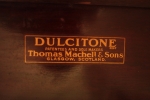
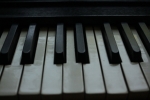
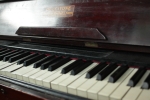


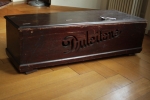
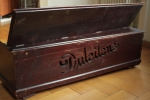



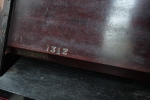
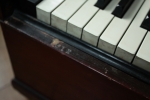
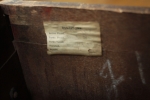

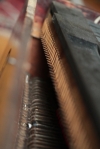

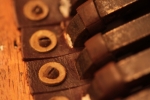

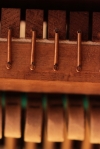
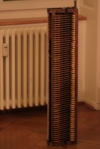


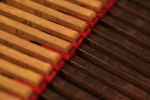


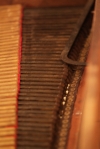


I have one with legs if you would like to see that. The legs on mine are somewhat ornate but you can make simple ones. The pedal is attached to the right front leg. And you are right, of course it had a pedal
Mike
hammeredstringspianos@gmail.com
I have a dulcitone in the uk! I bought it for less than £60 about 10 years ago. It’s not perfect, but I play it sometimes. Main problem with mine is sticky keys not jumping back up, though all the notes sound and a lovely sound it is too. Their value seems to depend entirely on how its being sold and varies a lot! I’d hate to sell mine and can totally see why you were prepared to pay that amount. I’d love to restore it, happy to get in touch if it helps at all. I feel a bit bad that there are so few and would happily loan it to orchestras etc but wouldnt know how to do so. I like to play clementi on mine 🙂
Hi there… thanks for commenting. I’m actually curious if you know where I could get the rubber rings that go round the tuning forks or some kind of equivalent . I have a few of those needing replaced.
This was posted a very long time ago, but if you are still struggling, i used a bunching burner tube and cut it up to size of the tuning fork.
I’m selling a dulcitone on behalf of an old, old lady in our village. It’s number 1383 and has all its bits. Hope I can get a grand for it!! She’d be so delighted. That would get her through two weeks at the care home.
Any offers or ideas where to sell it most pleased to receive.
Roxy
Put it on ebay but if your nervous about getting too little for it put a reserve price. If it’s in reasonable condition you should get at least a grand for it. Make sure you factor in the right shipping cost, that can be expensive.
Good luck!
Hello Roxy
Has the lady’s dulcitone been sold yet?
I’m a guy from Sweden who is completely obsessed with dulcitones and celestas and I’ve been searching all over for one so if it’s not too complicated to ship it over seas I’m definitely very interested.
Not sure how much a grand is though… 1000 pounds?
(I’m guessing that the dear old lady lives in the UK)
Do you know if it’s tuned flat like gordypop’s?
/Kristoffer
Yep, Grand is 1000. Sorry for my late late reply!
Hi Kristoffer
I have a Dulcitone .It is in very good condition .Has all parts working including folding legs
Its serial number is 198 and is a ” Thomas Machell” 3 1/2 octave So would suggest it is an early piece and very rare.
. Please contact me if you would like pictures or any other info. I would be prepared to sell if the price is right.
Regards
Henry
Hello
There is a section of felt under the forks. some of this could have rotted away which could contribute to the buzzing and can be fairly easily replaced by loosening the leather loops and lifting the individual forks. Time consuming but very much worth it.
Also some models came with a strip of wood with lots of nails in them that come down over and in between the forks to stop “jiggling” when transporting.
Regards
Thanks Ramon, I’m going to give that a shot for sure… just taking me some time…
How interesting to come across this site. I have a Dulcitone which was in a bit of a state – broken “ivories” and a number of notes missing, plus a large number of notes sagging. I have spent quite a bit of time over the last year on it, and now, although not perfect, does play pretty well and all notes return to the level. I managed to get some new key-tops from a man in the US, but apart from that, no new components were required..
there seams to be a bit of a debate as to whether the Dulcitone is a form of Celesta or a typophone, – any views.
Please can anyone advise me on how I can get mine reparied in hte London region? Some of the notes play well and others dont and the legs are veyr wobbly and need fixing…. thank you mobile 07903 337573
My advice is to try a piano builder or restorer. If they can’t do it they might know somebody that can.
I’d say it’s certainly more like a typophone, as it uses rods/forks rather than bells as the celeste does. Thanks for commenting Bill.
I have a Dulcitone on legs and its the bigger one, apparently 2 sizes. Rescued from a friends garage. He had brought it out to NZ after the first world war and had bought a farm near Wanganui. It is absolutely lovely although I need to learn to play it. I have spare piece to repair it if necessary and I think that the tone is even nicer than the one on the recording of the repaired on.
I have just inherited a Dulcitone. It has sat in a cupboard at my parent’s house for many years neglected. I was told it belonged to my grandmother who passed away in 1959 (before I was born). I was going to dispose of it, but decided to do a bit of research first. I came across your site which has the most information so far. I have decided to keep it and see if I can repair it. It is number 351 and made by Thomas Machell, so it must be one of the older ones. Maybe it belonged to my great grandmother or even her mother. All 3 of them were music teachers.
If you’re a musician I’d say the Dulcitone is something to hold onto and cherish. If you need repairs done the best bet is somebody who repairs pianos. If they won’t do it themselves, they might know somebody who would take it on. Personally I wouldn’t repair with a view to selling, were I going to sell, I’d just sell as is.
…and so lucky you didn’t just dispose of it!!! That would have been awful.
I don’t plan on selling!!
It’s great to read these comments. I bought my Dulcitone (which is in an oak case with barley twist legs) in a second hand shop here in Auckland (NZ) about 20 years ago. It sounded pretty terrible, but I’ve had it restored by a piano repairer in Melbourne and it’s heaps better.
Does anyone know where to get replacement key springs.
Did you get any answer on this –the request for how to get replacement springs??
I have a five octave Dulcitone by Thomas Machell & Sons with legs. I didn’t know until just now that it should have a number. But I haven’t found it. Where should it be? It has a screwed on label reading:-“Acotts The Music House Oxford.”
My number (351) is inside the lid on the lower left side.
Key springs: if you mean the small diameter brass springs at the end of the keys they are easy to make, if you can find the following (or quite close to the following).
– a coil of brass wire 0.45mm in diameter or so (e.g. from homecrafts.co.uk)
– a 2mm diameter rod, preferably steel, say 30cm/1ft long
– a horizontally mounted electric drill which will run really slow (I used an old Variac transformer to slow mine down); perhaps a lathe might be better, but I haven’t got one so I’ll refer to a drill.
1. Clamp down the drill, fit the rod in, and also clamp a piece of scrap wood with a hole in it at the other end of the rod to stop it from flapping about;
2. Push one end of the brass wire into the chuck alongside the rod;
3. Throw the coil of wire behind you, or otherwise rig up something that will allow it to unwind without tangling or snagging;
4. Start the drill. With your hands guide the wire onto the rod, keeping up a moderate tension with the wire just slipping through your fingers, so that it forms a close coil.
5. Keep going until you have a good length, or until you feel the rod is bending too much (I managed 25cm);
6. Stop the drill, take off the coil you’ve made.
7. To cut to length and form the end loops, the easiest thing is to push a scalpel or penknife down between turns, and just bend the coil over and cut as appropriate.
I hope that helps.
I haven’t opened mine up to see where these springs are. But I’m astonished that they should be made of brass. In normal engineering one doesn’t think of brass as a springy material. To make springs I’d choose Beryllium-Copper which is much superior. One can form it as John Kilpatrick suggests and then make it springy afterwards by suitable heat treatment. One must be careful however to handle it correctly as beryllium is toxic. Incidentally I’ve found the answer to my own question. I’ve found the number. Mine is 2396 and the number is on the bottom surface of the hinged flap at the front of the keyboard cover at the left hand end.
Hi I am hoping that i can send these photos of my spare parts and booklet on hints and adjusting the Dulcitone
Let me have your email if you want and I will send you the photos. I don’t know how to down load them onto this site. cheers Jan
I probably shouldn’t have given the homecrafts link, as I didn’t use their brass. What I used is 0.45mm brass harpsichord wire. It works fine as a tension spring, easily extending 50% before stretching.
I’ve taken the top off and posted a few pictures on http://www.johnkilpatrick.co.uk/instruments/dulcitone/index.htm to show the old and new springs. The old ones were overlength and pushed onto the nail part-way down the length: easy to pull off to remove the key, but I “don’t like it” and made springs the right length.
Also: I’ve included a photo of the signature on the soundboard. Does anyone know if the blurred bits above and below the name include a date? They are more-or-less unreadable because of the ink having run.
Would any of you lucky Dulcitone owners be interested in a small recording session for me? I am doing a version of a nursery rhyme and I am desperate to record a dulcitone for it – it’s such a beautiful and distinctive sound. Unfortunately I have been completely unable to find one, or anyone that owns one until I found this site.
I have a studio in London we could bring it to, or I am happy for you to record the part at home if you have any half decent recording equipment. It’s only a nursery rhyme so not particularly difficult (up to around grade 4 equivalent competency on the piano)
My email is nicholaswebb1979@gmail.com if anyone is interested in this!
Thanks again and good work all for keeping these special instruments alive!
Thank
My son bought a dulcitone at auction in Virginia (US) a few months ago and we are looking to have it restored (the serial number on ours is 2940). He’s a music performance major in college and knew immediately what it was. We’ve done research on it like everyone else, and came across some of the pages of the manual but not all of them. I can send copies of the pages we’ve found to anyone that wants them, and if you have the rest we’d love to see. I can send pictures of ours as well. It has foldable legs, and we found a triangular key at an antique show that fits the keyguard lock.
We have also been in contact with Whittakers Musical Museum in NZ. They have a nicely restored one on their site, and the restoration was done there at the museum. They are currently restoring a second one.
Hello. My name is Antoine Tharreau, I’m a french pianist. I’ve bought a Dulcitone in December 2019, and came in England to bring it back home (to France) in Febuary (2020). I’m actually restoring it. I’m interested by every usefull documents somebody would send me…
He’re my Email: antoine.tharreau@yahoo.fr
Thank you very much.
Antoine.
If you haven’t seen it already, you might like to look at my web page http://johnkilpatrick.co.uk/instruments/dulcitone/index.htm
John Kilpatrick
I recently inherited a dulcitone which has been in my family for a very long time. It’s still in quite good order but a couple of notes are not so good. I’ve been trying to find a repairer/tuner in Sydney Australia but haven’t had any luck so far. Can you help please?
Hi Robyn, I have one I inherited a few years ago. I am in Canberra and also looking for a repairer, but haven’t found one yet. If you find one please let me know, kafoley@tpg.com.au
I just bought a Dulcitone (#3009) at an estate auction in Concord, NC (US). Seems to be in great working order. These people must have had 15-20 old organs of various sorts, many pretty large. I paid $42.50 US for mine, which I thought was a good deal. I also bought a George A Prince folding melodeon for $2.50 US, which I have not tried to play just yet, but seems to work. The large organs were mostly not sold, I guess because of their size, or lack of advertising to proper people. They could have been had for $2.50 during the online auction, I believe. I think those are now going to a local auction house. If anyone is interested, I can try to find out more info on that. The man that owned the stuff worked on these for a hobby, and apparently had no heirs, other than money to go to Syracuse University. Anyone have an idea when the #3009 Dulcitone might have been manufactured.
I have a dulcitone which is in need of service: it has a cracked soundboard, many hammers and tuning forks need to be realigned. I am currently based in Milwaukee, WI and would be grateful for any leads in regards to service. Cheers.
My partner bought a new house. In the dilapidated shed was one of these instruments.
Sadly half the keys are jammed, the legs and sustain pedal are missing (legs appear to have snapped off).
I have it and am thinking about trying to see if I can get it working again.
Being a Scotsman and living in Scotland, I feel like it is something that I should at least attempt to do.
The only number I can see on it is “H15793”, but will see of there is another code somewhere on it.
Any tips for repair would be greatly appreciated.